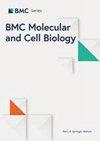Mice lacking DIO3 exhibit sex-specific alterations in circadian patterns of corticosterone and gene expression in metabolic tissues
IF 2.7
3区 生物学
Q4 CELL BIOLOGY
引用次数: 0
Abstract
Disruption of circadian rhythms is associated with neurological, endocrine and metabolic pathologies. We have recently shown that mice lacking functional type 3 deiodinase (DIO3), the enzyme that clears thyroid hormones, exhibit a phase shift in locomotor activity, suggesting altered circadian rhythm. To better understand the physiological and molecular basis of this phenotype, we used Dio3+/+ and Dio3-/- mice of both sexes at different zeitgeber times (ZTs) and analyzed corticosterone and thyroxine (T4) levels, hypothalamic, hepatic, and adipose tissue expression of clock genes, as well as genes involved in the thyroid hormone action or physiology of liver and adipose tissues. Wild type mice exhibited sexually dimorphic circadian patterns of genes controlling thyroid hormone action, including Dio3. Dio3-/- mice exhibited altered hypothalamic expression of several clock genes at ZT12, but did not disrupt the overall circadian profile. Expression of clock genes in peripheral tissues was not disrupted by Dio3 deficiency. However, Dio3 loss in liver and adipose tissues disrupted circadian profiles of genes that determine tissue thyroid hormone action and physiology. We also observed circadian-specific changes in serum T4 and corticosterone as a result of DIO3 deficiency. The circadian alterations manifested sexual dimorphism. Most notable, the time curve of serum corticosterone was flattened in Dio3-/- females. We conclude that Dio3 exhibits circadian variations, influencing the circadian rhythmicity of thyroid hormone action and physiology in liver and adipose tissues in a sex-specific manner. Circadian disruptions in tissue physiology may then contribute to the metabolic phenotypes of DIO3-deficient mice.缺乏 DIO3 的小鼠在皮质酮昼夜节律模式和代谢组织基因表达方面表现出性别特异性改变
昼夜节律紊乱与神经、内分泌和新陈代谢病症有关。我们最近发现,缺乏清除甲状腺激素的功能性3型脱碘酶(DIO3)的小鼠表现出运动活动的相移,这表明昼夜节律发生了改变。为了更好地了解这种表型的生理和分子基础,我们使用了不同昼夜节律时间(ZTs)的Dio3+/+和Dio3-/-雌雄小鼠,分析了皮质酮和甲状腺素(T4)水平、下丘脑、肝脏和脂肪组织的时钟基因表达,以及参与甲状腺激素作用或肝脏和脂肪组织生理学的基因。野生型小鼠控制甲状腺激素作用的基因(包括Dio3)表现出性双态昼夜节律模式。Dio3-/-小鼠在ZT12时下丘脑中几个时钟基因的表达发生了改变,但并没有破坏整体的昼夜节律特征。外周组织中时钟基因的表达并未因 Dio3 缺失而中断。然而,肝脏和脂肪组织中 Dio3 的缺失破坏了决定组织甲状腺激素作用和生理机能的基因的昼夜节律图谱。我们还观察到 DIO3 缺乏导致的血清 T4 和皮质酮的昼夜节律特异性变化。昼夜节律变化表现为性双态性。最值得注意的是,Dio3-/-雌性血清皮质酮的时间曲线变平。我们的结论是,Dio3表现出昼夜节律变化,以性别特异性的方式影响肝脏和脂肪组织中甲状腺激素作用和生理的昼夜节律性。组织生理学中的昼夜节律紊乱可能会导致DIO3缺陷小鼠的代谢表型。
本文章由计算机程序翻译,如有差异,请以英文原文为准。
求助全文
约1分钟内获得全文
求助全文
来源期刊

BMC Molecular and Cell Biology
Biochemistry, Genetics and Molecular Biology-Cell Biology
CiteScore
5.50
自引率
0.00%
发文量
46
审稿时长
27 weeks
 求助内容:
求助内容: 应助结果提醒方式:
应助结果提醒方式:


